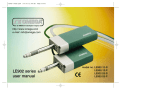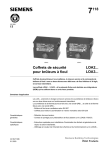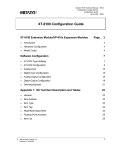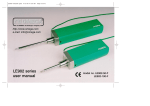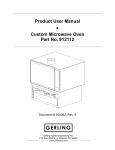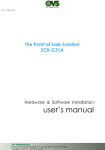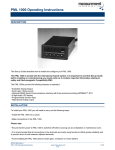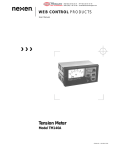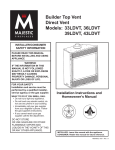Download DPL53 Digital Display user manual
Transcript
® http://www.omega.com e-mail: [email protected] DPL53 Digital Display user manual OMEGAnet ® On-Line Service http://www.omega.com Internet e-mail [email protected] Servicing Europe: Servicing North America: USA: ISO 9001 Certified Canada: One Omega Drive, Box 4047 Stamford, CT 06907-0047 Tel: (203) 359-1660 e-mail: [email protected] 976 Bergar Laval (Quebec) H7L 5A1 Tel: (514) 856-6928 e-mail: [email protected] Postbus 8034, 1180 LA Amstelveen, The Netherlands Tel: (31) 20 6418405 FAX: (31) 20 6434643 Toll Free in Benelux: 0800 0993344 e-mail: [email protected] Czech Republic: ul. Rude armady 1868, 733 01 Karvina-Hranice Tel: 420 (69) 6311899 FAX: 420 (69) 6311114 Toll Free: 0800-1-66342 e-mail: [email protected] France: 9, rue Denis Papin, 78190 Trappes Tel: (33) 130-621-400 FAX: (33) 130-699-120 Toll Free in France: 0800-4-06342 e-mail: [email protected] FAX: (203) 359-7700 FAX: (514) 856-6886 For immediate technical or application assistance: USA and Canada: Sales Service: 1-800-826-6342 / 1-800-TC-OMEGASM Mexico and Latin America: Benelux: Customer Service: 1-800-622-2378 / 1-800-622-BEST SM Engineering Service: 1-800-872-9436 / 1-800-USAWHENSM TELEX: 996404 EASYLINK: 62968934 CABLE: OMEGA Tel: (95) 800-826-6342 FAX: (95) 203-359-7807 En Españ ol: (95) 203-359-7803 e-mail: [email protected] Germany/Austria: Daimlerstrasse 26, D-75392 Deckenpfronn, Germany Tel: 49 (07056) 3017 FAX: 49 (07056) 8540 Toll Free in Germany: 0130 11 21 66 e-mail: [email protected] United Kingdom: One Omega Drive, River Bend Technology Centre ISO 9002 Certified Northbank, Irlam, Manchester M44 5EX, England Tel: 44 (161) 777-6611 FAX: 44 (161) 777-6622 Toll Free in the United Kingdom: 0800-488-488 e-mail: [email protected] It is the policy of OMEGA to comply with all worldwide safety and EMC/EMI regulations that apply. OMEGA is constantly pursuing certification of its products to the European New Approach Directives. OMEGA will add the CE mark to every appropriate device upon certification. The information contained in this document is believed to be correct, but OMEGA Engineering, Inc. accepts no liability for any errors it contains, and reserves the right to alter specifications without notice. WARNING: These products are not designed for use in, and should not be used for, patient-connected applications. DPL53 M-3334 09/05 1.0: Index Section Title Page Section Title Page 1.0 Index . . . . . . . . . . . . . . . . . . . . . . . . . . . . . . . .1 7.4 Calibration . . . . . . . . . . . . . . . . . . . . . . . . . . .23 2.0 Safety Summary . . . . . . . . . . . . . . . . . . . . . . .2 7.5 Scaling option . . . . . . . . . . . . . . . . . . . . . . . .24 3.0 Handling and Maintenance . . . . . . . . . . . . . .3 7.6 Configuring Alarms . . . . . . . . . . . . . . . . . . . .24 4.0 Installation into a panel . . . . . . . . . . . . . . . . .4 7.7 Analogue Output . . . . . . . . . . . . . . . . . . . . . .27 4.1 Installation Instructions . . . . . . . . . . . . . . . . . .4 7.8 Configuring Serial Communications . . . . . . .29 4.2 Installation Dimensions . . . . . . . . . . . . . . . . .5 7.9 Status Logic Inputs . . . . . . . . . . . . . . . . . . . .30 5.0 Using the Button Controls . . . . . . . . . . . . . . .6 7.10 Configuring Function Keys . . . . . . . . . . . . . .33 6.0 Setup Options . . . . . . . . . . . . . . . . . . . . . . . .7 7.11 System Options . . . . . . . . . . . . . . . . . . . . . .34 6.1 Transducer Connection to DPL53 . . . . . . . . .7 8.0 RS232 Communications with DPL53 . . . . . .37 6.2 LDVT Sensitivity, Stroke Length, Excitation 9.0 DPL53 Messages . . . . . . . . . . . . . . . . . . . . .46 Voltage and Frequency . . . . . . . . . . . . . . . . .8 9.1 Error Messages . . . . . . . . . . . . . . . . . . . . . . .46 6.3 Calibration . . . . . . . . . . . . . . . . . . . . . . . . . . .13 9.2 Alarm Messages . . . . . . . . . . . . . . . . . . . . . .47 6.4 Scaling . . . . . . . . . . . . . . . . . . . . . . . . . . . . . .17 Appendix A Control Panel Connections . . . . . . . . . .48 7.0 Description of the DPL53 Functions . . . . . . .19 Appendix B DPL53 Menu Options . . . . . . . . . . . . . .49 7.1 Configuring the Display . . . . . . . . . . . . . . . . .19 Appendix C Product Specification . . . . . . . . . . . . . .51 7.2 LVDT Configuration . . . . . . . . . . . . . . . . . . . .21 Appendix D Memory Locations . . . . . . . . . . . . . . . . .52 7.3 Null Position . . . . . . . . . . . . . . . . . . . . . . . . . .23 1.0 Index DPL53 1 M-3334 09/05 2.0: Safety Summary Terms in this Handbook Installation and Removal WARNING statements identify conditions or The DPL53 is designed for installation in an practices that could result in personal injury or loss enclosure which provides adequate precaution of life. against electric shock. Access to power terminals should be restricted to authorised skilled personnel CAUTION statements identify conditions or practices only. that could result in damage to the equipment or Application of supply voltages higher than those for other property. which the instrument is intended may compromise safety and cause permanent damage. Symbols in this manual This symbol identifies where cautionary or other NOTES: safety related information is to be found. This equipment contains no user serviceable parts This equipment must be returned to your Omega WARNINGS: dealer for all servicing and repair. Do not operate in an explosive atmosphere To avoid explosion, do not operate this equipment in an explosive atmosphere. 2.0: Safety Summary DPL53 2 M-3334 09/05 3.0: Handling and Maintenance The DPL53 is a precision instrument and should be handled with care. The DPL53 is designed to be maintenance free. Contacts with solvents should be avoided. Any attempt to dismantle the DPL53 or the LVDT transducer will invalidate the warranty. There are no user accessible points. 3.0: Handling & Maintenance DPL53 3 M-3334 09/05 4.0: Installation into a Panel 4.1 Installation Instructions Panel Mounting Warnings • Ensure that there is sufficient space behind the 1. On installing or removing the DPL53 you must relevant instrument panel for the DPL53 and its be aware of any hazardous equipments or cabling (see section 4.2 for dimensions). materials in the vicinity. Make sure that any • Cut out the panel aperture to the dimensions shown. equipment into which the DPL53 system is to • Slide the rubber seal over the unit, and push it be installed is switched off and made safe. forward until it sits behind the front lip of the unit. 2. All connections to the terminal should be made • Working from behind the panel, with the box fully using ferrules to give reliability and prevent located, fit the side brackets to the studs and slide short circuits between adjacent terminals. them forward toward the panel until they lock into place. Cautions • Screw the brackets to the panel. 1. Avoid installing the DPL53 close to switch gear, contactors or motor starters. Caution 2. Do not place signal and power supply wiring in Do not overtighten the screws as this may the same loom as the DPL53 wiring. damage the case of the instrument. 3. Use screened cables for all leads, with the screen earthed at one end only. 4.0: Installation into a Panel DPL53 4 M-3334 09/05 4.0: Installation into a Panel (Continued) 4.2 Installation Dimensions 4.0: Installation into a Panel DPL53 5 M-3334 09/05 5.0: Using the Button Controls There are FOUR levels of button control KEY TO BUTTONS:NEXT UP DOWN ENTER RESET The complete chart showing all button indications is shown in Appendix A. 5.0: Using the Button Controls DPL53 6 M-3334 09/05 6.0: Setup Options 6.1 Transducer Connection to DPL53 The DPL53 works with the range LVDT transducers from Omega. Below are the details on how to connect the transducer to the DPL53 6.0: Setup Options DPL53 7 M-3334 09/05 6.0: Setup Options 6.2 LVDT Sensitivity, Stroke Length, Excitation Voltage and Frequency The process for LVDT sensitivity and stroke length depends on the availability of data. A. If the sensitivity and stroke length are known (for example, supplied with the system on data sheets) then the data is entered as shown in sub-menu A. Sub-Menu A - If sensitivity and stroke length are known. B. If the sensitivity and stroke length are unknown then the Auto-on option is selected as shown in sub-menu B. Sub-Menu B - If sensitivity and stroke length are unknown. 6.0: Setup Options DPL53 8 M-3334 09/05 6.0: Setup Options 6.2 Setting the LVDT Sensitivity, Stroke Length, Excitation Voltage and Frequency With reference to “Using the Button Controls” (section 5) and to the full menu in Appendix B, proceed to set the sensitivity, stroke length, excitation voltage and frequency as follows:Action Button Number Action 1. Press and hold for 5 seconds 2. Press three times 3. Press and release 4. Press and release 5. Press and release Display Additional Display Information If the sensitivity and stroke length are known. Press and release : Go to action number 6 If the sensitivity and stroke length are unknown Press and release Note: Toggles Press and release between On and OFF setting Press and release Press and release 6.0: Setup Options DPL53 : Go to action number 18 9 M-3334 09/05 6.0: Setup Options 6.2 Setting the LVDT Sensitivity, Stroke Length, Excitation Voltage and Frequency cont’d To change the setting to a different Sensitivity, (for example, a transducer, at 200 mV/V/mm). Action Button Number Action Display Additional Display Information 6. Press and release 7. Press and release 8. Press and release Example figure only (with right hand figure flashing 9. Press and release four times moves flashing figure to the left 10. Press and release two times reduces flashing number from 4 to 2 11. Press and release once decimal point flashes 12. Press and release once moves the decimal point one place to the right 13. Press and release once 14. Press and release 15. Press and release 16. Repeat actions 11 to 14 to input the transducer stroke length setting. 6.0: Setup Options DPL53 default stroke setting 10 M-3334 09/05 6.0: Setup Options 6.2 Setting the LVDT Sensitivity, Stroke Length, Excitation Voltage and Frequency cont’d Action Button Number 17. Action Display Additional Display Information Press and release Excitation Voltage 18. Press and release 19. Press and release The two options are 3V AC and 5V AC The default is 3V. To obtain 5V press 20. Press and release Excitation Frequency 21. Press and release 22. Press and release The two options are 2.5KHz and 5KHz The default is 2.5KHz. To obtain 5KHz press 6.0: Setup Options DPL53 11 M-3334 09/05 6.0: Setup Options 6.2 Setting the LVDT Sensitivity, Stroke Length, Excitation Voltage and Frequency cont’d Action Button Number Action Display Additional Display Information Return to Level 1 23. Press and release 24. Press and release 25. Press and release three times 6.0: Setup Options DPL53 Returns to main display 12 M-3334 09/05 6.0: Setup Options 6.3 Calibration Calibration is the registering of the LVDT transducer minimum and maximum displacement position into the DPL53 display unit. Before proceeding with the calibration, leave the power on for 30 minutes. The procedure given is for an example of a step gauge, with low and high settings of 0.00 mm and 10.0 mm respectively. With reference to the Indicator Chart in Section 5 and Appendix B, calibrate the LVDT transducer as in the following table. 6.0: Setup Options DPL53 13 M-3334 09/05 6.0: Setup Options 6.3 Calibration cont’d Action Button/ Number Step gauge Action 1. Press and hold for 5 seconds 2. Press three times 3. Press and release 4. Press and release 3 times 5. Press and release 6 Step gauge 7 8 Step gauge Display Additional Display Information Set to zero (page 15) Press and release for three seconds then Set to high point (eg; 10 mm) for three seconds then (page 15) 9 6.0: Setup Options DPL53 Press and release twice returns to main display 14 M-3334 09/05 6.0: Setup Options 6.3 Calibration cont’d 6.0: Setup Options DPL53 15 M-3334 09/05 6.0: Setup Options 6.3 Calibration cont’d Calibration Error Codes The instrument has detected an error during calibration caused by the output of the LVDT being greater than the maximum positive input level of the instrument at the specified sensitivity. The instrument has detected an error during calibration caused by the output of the LVDT being lower than the specified sensitivity. The instrument measured the same output from the LVDT at both calibration points. (High = Low). 6.0: Setup Options DPL53 16 M-3334 09/05 6.0: Setup Options 6.4 Scaling Scaling is to set the display to show the correct With reference to the Indicator Chart shown in Section 5 displacement for your LVDT, the LOW and HIGH display (Using Button Controls) and Appendix B, scale the values need to be defined. The procedure given is for LVDT transducer as in the example table below:- an example of scaling of between a minimum of 95 mm and a maximum of 105 mm. Action Button/ Action Number Micrometer 1 Press and hold for 5 seconds 2 Press three times 3 Press and release once 4 Press and release four times 5 Press and release once 6 Press and release once Display assumed example Additional Display Information with right hand number flashing To set the lower figure (for example 95) 7 6.0: Setup Options DPL53 Press and release four times moves flashing number to the left 17 M-3334 09/05 6.0: Setup Options 6.4 Scaling cont’d Action Button/ Action Number Micrometer Display Additional Display Information 8 Press and release eight times increases the flashing number from 1 to 9 9 Press and release four times moves flashing number to second left 10 Press and release five times increases flashing number from 0 to 5 11 Press and release ‘n’ times until decimal point flashes 12 Press and release once moves decimal point one place to the right 13 Press and release once To set the upper figure (for example 105) 14 Press and release once 15 Press and release once 16 Press the buttons in a similar manner to actions 7 to 13 to obtain 17 Press and release once 18 Press and release 3 times 6.0: Setup Options DPL53 returns to main display 18 M-3334 09/05 7.0: Description of the DPL53 Functions This chapter describes the functions which the DPL53 can carry out. Each section is headed with Level 2 menu option (Refer to 5.0 Using the Button Controls). 7.1 Configuring the Display Display Function Decimal Point Position Allows the position of the decimal point to be fixed or auto ranging. The decimal point may be fixed to give 0, 1, 2, 3 or 4 digits after the decimal point. The default is 1 decimal point. Display Update Rate Allows the update rate of the display to be set from every 0.1 seconds to 0.5 seconds. The options are 2, 4 or 10Hz, the default setting is 2Hz. Display Filtering Used to set up filtering of displayed values. The time constant of the filter entered in seconds. The default value is zero (no display filtering). Least Significant Digit Zero When set to ON the right hand digit only displays zero during normal running. The default is OFF. 7.0 Description of DPL53 Functions DPL53 Description 19 M-3334 09/05 7.0: Description of the DPL53 Functions 7.1 Configuring the Display. cont’d Display Description Function Display Negative Numbers Allows the display of negative numbers to be enabled (ON) or disabled (OFF). The default setting is negative numbers ON. Leading Zero Suppression Allows leading zeros to be displayed. When ON the leading zeros are not displayed. The default is ON. Allows the brightness of the display to be adjusted in the range 1 to 4. The default setting is 4 (highest intensity setting). Brilliance Font One of two fonts for the display of numerals may be selected to allow compatibility with some older instruments. The default font is 1. Test Performs a display test which illuminates all display digits and segments (8.8.8.8.8.) when the enter button is pressed. 7.0 Description of DPL53 Functions DPL53 20 M-3334 09/05 7.0: Description of the DPL53 Functions 7.2 LVDT Configuration Before any calibration or scaling operations are performed some operating parameters related to the use of the particular LVDT need to be set. These parameters are all set up from the input menu Display Function Description Allows the instrument to set its gain automatically by determining the sensitivity of the attached LVDT during Calibration. The options are Automatic Gain Selection Enabled (ON) or disabled (OFF), this is the default state. Note: When the AUTO option is set to ON. The sesitivity and stroke options will not be accessible. Automatic Gain Selection Value is entered to allow the gain of the measurement input of the instrument to be determined from the specified sensitivity of the LVDT. Details of the sensitivity of your LVDT should be in the documentation supplied. Sensitivity Allows the stroke of the LVDT to be entered as a value directly in mm. In order to determine the appropriate gain setting. The default stroke setting is 100.0mm. Stroke 7.0 Description of DPL53 Functions DPL53 21 M-3334 09/05 7.0: Description of the DPL53 Functions 7.2 LVDT Configuration cont’d Display Function Description Selects the correct output voltage for excitation for the LVDT. The appropriate voltage to use will be specified in the LVDT documentation. There are two options 3V AC and 5V AC (rms.), the default setting is 3V. Excitation Voltage Sets the correct excitation frequency as specified in the LVDT documentation. The options are 2.5KHz or 5KHz. The default is 2.5KHz. Excitation Frequency 7.0 Description of DPL53 Functions DPL53 22 M-3334 09/05 7.0: Description of the DPL53 Functions 7.3 Null Position This function allows the user to locate the midpoint of the LVDT’s measurement range (Null Point). Display Function Description The value will be displayed ‘FLASHING’. The closer the value to zero, the nearer the LVDT is to its ‘NULL POSITION’. Null Position 7.4 Calibration This menu option is described in more detail in Section 6.3 Calibration. Display Function Description Low Input Allows unit to calibrate to the minimum displacement position of the LVDT. Wait High Input When wait elapses ‘high input’ is displayed and the LVDT is set to its maximum displacement position. High=Low The instrument measured the same output from the LVDT at both calibration points. 7.0 Description of DPL53 Functions DPL53 While the low and high input positions are being calibrated, ‘wait’ is displayed. 23 M-3334 09/05 7.0: Description of the DPL53 Functions 7.5 Scaling Option This menu option is described in more detail in Section 6.4 Scaling. Display 7.6 Function to Description Low (Zero) Display The minimum displacement display which corresponds to the Low calibration point ( L - i P). Default is zero. High Scale Display The maximum displacement display which corresponds to the High calibration point ( H - i P ). Default is 100.0. Configuring Alarms There are four Alarms; each can be configured separately. All Alarms default to OFF. Note 1: Only relay outputs can be activated by the Alarms. Note 2: The alarms are not affected by the analogue output. Display Description Function Options are none (OFF), high, low and deviation. Alarm 1 and 3 default to high and Alarm 2 and 4 default to low. Alarm Type There are four setpoints, one for each of the four alarms. Each set point may be set to any value within the display range of the instrument i.e. -19999 to 99999. The default setpoints are 99999 for Alarm 1 and Alarm 3 and -19999 for Alarm 2 and Alarm 4. Setpoint 7.0 Description of DPL53 Functions DPL53 24 M-3334 09/05 7.0: Description of the DPL53 Functions 7.6 to Display cont’d Description Function This allows the difference between the alarm setpoint and the high and low deviation levels to be defined. The default setting for both is zero. These menu options are only displayed (and valid) when the alarm type is set to deviation. Deviation Setpoints All alarms may be set to latched (ON) or non-latched (OFF). When alarms are set to latched then the alarm indication and any associated output will remain in the active state even when the alarm condition has cleared. Latched alarms must be acknowledged to clear indications and outputs to their inactive (non-alarms) states. To acknowledge an alarm; either press the UP and DOWN arrow keys together or configure one of the two status inputs as an alarm acknowledge (ACK). The default setting is OFF (non-latching). The alarm condition must be cleared before the alarm can be acknowledged. Latching Allows you to specify which output is activated when the alarm condition is valid. The dual relay options are OP1 (Relay 1) or OP-2 (Relay 2). Output 7.0 Description of DPL53 Functions DPL53 25 M-3334 09/05 7.0: Description of the DPL53 Functions 7.6 to Display cont’d Description Function Allow the on and off delay times for each of the alarms to be defined. The on delay defines the time that the alarm condition must be present before the alarm is activated. The off delay defines the time, that the alarm condition is cleared before the alarm is deactivated. The default setting for both the on and off delay is zero. Delay Define the difference between the set point and the point at which the alarm is activated or deactivated. The on and off Hysteresis may be specified separately above and below the setpoint. Hysteresis When this facility is ON the operator may access the alarm setpoints from the front panel by pressing the DOWN arrow key and without having to enter the configuration menus. The default is ON. Front Panel Edit This parameter allows you to define whether alarm messages are displayed (ON) or not (OFF). The default setting is ON. Message Display 7.0 Description of DPL53 Functions DPL53 26 M-3334 09/05 7.0: Description of the DPL53 Functions 7.7 Analogue Output Display Description Function Linked Setpoints (Alarm menu 3 and 4 only) This allows you to link setpoint 3 to setpoint 1, and setpoint 4 to setpoint 2. When setpoints are linked, setpoint 1 will automatically change to setpoint 3 values. Changing setpoint 2 will change setpoint 4. The default is OFF (No setpoint linking). Output Type Allows the output to be set to 0-10V, 0-20mA or 4-20mA. The default setting is 4-20mA. Defines the source of the values to be output. The source can be selected from the display value (inPt), maximum or peak value (High), minimum value (LOU), average value (Av) or a value received from the communications interface (Conn). The default is inPt. Signal Source Defines the display value at which the output will reach its minimum level ie: 4mA (4-20mA), 0mA (0-20mA) or 0V (0-10V) dependent on analogue output type selected above. The default value is 0%. Low Scaling Point 7.0 Description of DPL53 Functions DPL53 27 M-3334 09/05 7.0: Description of the DPL53 Functions 7.7 Analogue Output cont’d Display Description Function Defines the display value at which the output will reach its maximum level ie: 20mA (0 or 4-20mA) or 10V (010V) dependent on analogue output type selected above. The default value is 100%. High Scaling Point Output damping defines the time constant in seconds for damping the output. This parameter is used to limit the rate of change of the output and may be adjusted in the range 0 to 999 seconds. The default is 0. Damping 7.0 Description of DPL53 Functions DPL53 28 M-3334 09/05 7.0: Description of the DPL53 Functions 7.8 Configuring Serial Communications The DPL53 can communicate with a master device via an RS232 interface. For more detailed information refer to 8.0 RS 232 Communication. Display Function Description Instrument Address Defines the instrument address when using the instrument in a multidrop system. The range of valid addresses is 1 - 247. The default is 1. Baud Rate Allows the baud rate to be selected. The options are 1200, 2400, 4800 and 9600. The default is 9600. Protection Allows the instrument parameter settings to be protected against change from the serial interface (write protection ON). The default is OFF. Parity Defines parity for all communications. The options are even, odd or no parity. The default is Even. Defines the number of stop bits, 1 or 2. The default is 1. Stop Bits Add a delay, in milliseconds, before the DPL53 responds to any received commands. Transmit Delay 7.0 Description of DPL53 Functions DPL53 29 M-3334 09/05 7.0: Description of the DPL53 Functions 7.9 Status Logic Inputs The DPL53 provides two status (logic) inputs which can be assigned to perform one or more functions when activated. All functions are started when there is a low on the status input i.e. placing a short across the input (from a switch or relay). The calibration function is started when there is a transition from in-active to active state on the input. Display Function Description Alarm Acknowledge Clears all latched alarms which are no longer in an alarm condition. The default is OFF. Alarm Disable Disables all alarms when the status inputs is active. The default is OFF. Allows any one of the following to be displayed whilst the status input is active: Lamp test, the average, low or high values, or display hold. When the status input is inactive the normal measured value is displayed. The default for this is NONE. Displays This resets the High (peak), Low (minimum) and Average values to the current measured value. The default for this option is OFF. Reset 7.0 Description of DPL53 Functions DPL53 30 M-3334 09/05 7.0: Description of the DPL53 Functions 7.9 Status Logic Inputs cont’d Display Description Function Disables the front panel keys, the default state is OFF. Front Panel Keypad Disable This allows the analogue output to be held at a (Frozen) level. The default state is OFF. Analogue Output Hold Auto Fast Calibration This is used to initiate the automatic calibration process. The process is started when the status input is activated. The default for this option is OFF. Zeroing This sets the measured and displayed values to Zero (0.000) permanently (or until the instrument is defaulted), removing any offset errors from the system. This tares the measured value subtracting a fixed amount from all subsequent measurements. The default is ON. Tare 7.0 Description of DPL53 Functions DPL53 31 M-3334 09/05 7.0: Description of the DPL53 Functions 7.9 Status Logic Inputs cont’d Display Description Function This enables or disables the display of messages related to the status input function. When ON messages are displayed alternately with value being displayed ie: if the unit is displaying the high value, then the high value is displayed flashing with the message ‘HiGH’. This indicates to the user that the current input value was not being displayed. The default is ON. Status Message Display 7.0 Description of DPL53 Functions DPL53 32 M-3334 09/05 7.0: Description of the DPL53 Functions 7.10 Configuring Function Keys There are 2 function keys which can be configured. Function Key 1 functions may be assigned to either or both keys unless stated. Display If ON, the function button will reset the High (Maximum), Low (minimum) and Average values to the current measured value. The default is OFF. Reset When ON then the function key 1 or 2 will initiate the automatic calibration process. When pressed the display will flash the message ‘CAL’. The key must be pressed again whilst the display is flashing to perform the function. The default state is OFF. Auto Fast Calibration Tares the measured value, subtracting a fixed amount from all subsequent measurements. The value subtracted is the current value when the key is pressed. When the function is assigned to a function key, pressing the key once will activate the tare (relative displacement) measurement. Pressing the key again while tare is active will deactivate the function. Default is ON. Tare DPL53 . The following Description Function 7.0 Description of DPL53 Functions and Function Key 2 33 M-3334 09/05 7.0: Description of the DPL53 Functions 7.10 Configuring Function Keys cont’d Display Description Function This sets the measured and displayed values to Zero (0.000) permanently (or until the instrument is defaulted or calibrated), removing any offset errors from the system. When assigned to a function key pressing the key once will cause the DPL53 to display ‘ZEro’ flashing. To perform the ‘Zero’ the function key must be pressed again, to confirm the operation, (the display will flash for approximately 5 seconds). Once confirmed, the ‘Zero’ will be performed immediately. The default is OFF. Zeroing Allows any one of the following to be displayed whilst the Function key is pressed: Lamp test, the average, low or high values, or display hold. When the key is released normal display is returned. The default is NONE (no display function). Displays 7.0 Description of DPL53 Functions DPL53 34 M-3334 09/05 7.0: Description of the DPL53 Functions 7.11 System Options Display Function Description Enter any value between 1 and 99999. When enabled the configuration menu cannot be accessed without first entering the password number. The default value is 0. (No Password). Password This average value is not a true arithmetic average. The default is 1 (second). Averaging Time Allows the unit to reset back to its factory default settings. Select ON to default the instrument. It will automatically revert to OFF when the instrument is defaulted. Default 7.0 Description of DPL53 Functions DPL53 35 M-3334 09/05 7.0: Description of the DPL53 Functions 7.11 System Options cont’d Display Description Function This defines the time that the unit will remain in configuration mode when there is no key activity. If there are no key presses within the specified time period the unit will return to normal operation. the default time-out is 60 seconds and is adjustable between 30 to 300 seconds. This is disabled during the Calibration sequence. Time-out Reset Allows the unit to be reset. The reset process, when activated, will display Wait and start the sequence. The unit will reset back to its factory default settings, and go through the power-up sequence. Type Shows the type of readout ie: DPL53. Version 7.0 Description of DPL53 Functions DPL53 Shows the version of the DPL53. 36 M-3334 09/05 8.0: RS232 Communications with DPL53 8.1 Overview 8.2 DPL53 Connections to RS232 communication This language has been developed for communication The connections required to interface the DPL53 to a between the DPL53 and the master device via an RS232 RS232 interface are shown below. communications interface. The master device could be a computer, which would be able to read from and write to, memory locations within the DPL53. There are two types of memory locations, analogue and logic. Analogue memory locations can be set to any value within a specified range. Logic locations can be set to either ON or OFF. A full list of the memory location within the DPL53 are listed in Appendix D. Memory Locations. 8.0: R232 Communications with DPL53 DPL53 RS232 connection to a Master device (Computer). 37 M-3334 09/05 8.0: RS232 Communications with DPL53 A screened twisted pair cable should be used for all 8.3 DPL53 Settings for RS232 communication applications requiring cable lengths greater than 3m. The screen of the cable should be connected to the The default setting for the DPL53 are as follows: Frame Ground or Ground connection of the Master Parameter device. Communications Address Baud Rate Default Settings 1 9600 Several DPL53's can be connected to a computer, each Write Protect Off DPL53 with its own identification number. Parity Even Stop Bits 1 Bit Note: The data length for the RS232 is set to 7 bits and can not be changed. The parameters Communications address, Baud rate, Write Protect, Parity and Stop Bits can be changed. Refer to section 7.8 Configuring Serial Communications. 8.0: R232 Communications with DPL53 DPL53 38 M-3334 09/05 8.0: RS232 Communications with DPL53 APPLICATION NOTE: Simple connection between DPL53 Digital Display and Connection between DPL53 Digital Display and Master Master device. (Computer). device. (Computer). (Using NO flow control between Master device (i.e. (Setting Master device which has flow control signals). PC)). 8.0: R232 Communications with DPL53 DPL53 39 M-3334 09/05 8.0: RS232 Communications with DPL53 8.4 General format of commands [address] All commands sent to the DPL53 must be written in is the communications address of the DPL53, in the range 1 to 247. upper case. [command] is a DPL53 command. The syntax for a command to the DPL53 is as follows: [location] ;E_[address]_[command]_[location]_[data]<CR><LF> location. where: ; is the DPL53 internal analogue or logic [data] for read commands (RA and RL) this must start every command. If there is a ";" in the parameter specifies how many analogue or middle of a command, the DPL53 will ignore logic locations are to be read. For write everything before the ";". You can abandon a commands (SA and SL), defines how many command by typing ";" at the end of it. to be written to the specified analogue or logic location. E is optional. This will cause the DPL53 to echo the command before responding. _ indicates a SPACE. 8.0: R232 Communications with DPL53 DPL53 40 <CR> is a carriage return. <LR> is a line feed. M-3334 09/05 8.0: RS232 Communications with DPL53 8.5 Commands Reply. ;E_001_RA_2_1_+123.45<CR><LF> 8.5.1 RA command Part Description Description. ;E_001_RA_2_1 is the echo of the original command. Read an analogue location within the DPL53. +123.45 is the value from location 2. Example Command. ;E_001_RA_2_1<CR><LF> Part Description ;E starts the message and requests the DPL53 to echo the command before replying. 001 is the communications address of the DPL53. RA_2_1 is the command to read the value from 1 analogue location 2. <CR><LF> marks the end of the command. 8.0: R232 Communications with DPL53 DPL53 41 M-3334 09/05 8.0: RS232 Communications with DPL53 8.5.2 SA Command Reply. OK<CR><LF> Description. Part Description Set an analogue location within the DPL53. ; due to there being no ;E, the echo of the original command. Example Command. ;001_SA_63_100<CR><LF> OK message reply from DPL53, saying message was received and understood. Part Description ;001 is the communications address of the DPL53. SA_63_100 is the command to set the value of analogue location 63 to 100. <CR><LF> marks the end of the command. 8.0: R232 Communications with DPL53 DPL53 42 M-3334 09/05 8.0: RS232 Communications with DPL53 8.5.3 RL Command Reply. ;E_001_RL_48_1_ON<CR><LF> Description. Part Read the state of a logic location within the DPL53. ;E_001_RL_48_1 is the echo of the original command. ON Description is the value from location 48. Example Command. ;E_001_RL_48_1<CR><LF> Part Description ;E starts the message and requests the DPL53 to echo the command before replying. 001 is the communications address of the DPL53. RL_48_1 is the command to read the values from location 48. <CR><LF> marks the end of the command. 8.0: R232 Communications with DPL53 DPL53 43 M-3334 09/05 8.0: RS232 Communications with DPL53 8.5.4 SL Command Reply. OK<CR><LF> Description. Part Description Sets the state of a logic location within the DPL53. ; due to there being no ;E, the echo of the original command. Example Command. ;001_SL_140_ON<CR><LF> OK message reply from DPL53, saying message was received and understood. Part Description ;001 is the communications address of the DPL53. SL_140_ON is the command to set the logic locations state to ON at location 140. <CR><LF> marks the end of the command. 8.0: R232 Communications with DPL53 DPL53 44 M-3334 09/05 8.0: RS232 Communications with DPL53 8.6 Error Messages If the command is incorrect, the DPL53 returns a # followed by an error code. The error codes are as follows. Error Code Meaning 1 Invalid message Example/Explanation ;E_001_RS_31_3<CR><LF> "RS" is not a valid command. 2 Invalid/Read only location ;E_001_SL_33ON<CR><LF> Logic location 33 is read only location. 3 Non existent location ;E_001_RA_310_1<CR><LF> Analogue location 310 does not exist. 4 Invalid value ;E_001_RA_21_ON<CR><LF> ON is not a valid value for analogue location 21. 5 Unaccepted value 6 Instrument error 7 Reserved location The DPL53 is inside a Configuration Menu. The DPL53 is not operating correctly. ;E_001_SA_91_100<CR><LF> Analogue location 92 is a reserved location. 8 Too many data requests 9 Too many arguments The DPL53 is still busy dealing with previous commands. ;E_001_RA_SA_31_3<CR><LF> There are two commands present, "RA" and "SA". 8.0: R232 Communications with DPL53 DPL53 45 M-3334 09/05 9.0: DPL53 Messages 9.1 Error Messages The instrument has detected a problem with the sensor resulting in an open circuit input, this These messages indicate that an error has may be caused by a break in one of the leads from the been detected in one of the instruments internal transducer or a fault in one of the transducer elements. memory areas as part of power up self test sequence. The measured value is too large positively This indicates that the instrument has to be displayed, or is above the specified input range. detected a fault in its measurement circuitry. The measured value is too low negatively The instrument has detected a problem or to be displayed, or is below the specified minimum error in its non volatile memory resulting in a loss of input for the selected range. calibration data. Note: For any of the above error messages return the Note: For any of the above messages check instrument instrument to the supplier. settings. 9.0: DPL53 Messages DPL53 46 M-3334 09/05 9.0: DPL53 Messages 9.2 Alarm Messages Alarm messages will be displayed alternately with the normal display only one alarm message will be displayed at any time. Deviation type alarm has been triggered on the indicated alarm at the low deviation setpoint. eg: Lod4 = Low Deviation Alarm, Alarm 4. Low alarm has been triggered on the indicated alarm. eg: LoA3 = Low Alarm, Alarm 3. Deviation type alarm has been triggered on the indicated alarm at the high deviation setpoint. High alarm has been triggered on the indicated alarm. 9.0: DPL53 Messages DPL53 47 M-3334 09/05 Appendix A: Control Panel Connections Terminal 1 2 3 4 5 6 7 8 9 10 11 12 13 14 15 16 17 18 19 20 21 22 23 24 25 26 Appendix A: Connections DPL53 48 No alarm Relay 1 - Common Relay 1 - Normally Open Relay 1 - Normally Closed Relay 2 - Common Relay 2 - Normally Open Relay 2 - Normally Closed O/P DC LVDT Primary LVDT Primary RS232 Tx RS232 Gnd RS232 Rx N/C Status (Logic) Input 2 Status (Logic) Input 1 Status Input Common (GND) Power Input Neutral (-) Power Input Live (+) High Speed Analogue Output High Speed Analogue Output + N/C N/C N/C N/C LVDT Secondary LVDT Secondary M-3334 09/05 Appendix B: DPL53 Menu Options (Part 1) Appendix B:DPL53 Menu Options DPL53 49 M-3334 09/05 Appendix B: DPL53 Menu Options (Part 2) Appendix B:DPL53 Menu Options DPL53 50 M-3334 09/05 Appendix C: Specification for DPL53 Excitation Voltage Frequency Temperature drill Supply 3V AC rms. or 5V AC rms. selectable 2.5kHz or 5kHz selectable (amplitude) <100ppm/°C (frequency) <100ppm/°C Operating Conditions Ambient Temperature High Speed Analogue O/P Output ±10V maximum Response Output filter -3dB @ 125Hz Analogue Output Ranges Accuracy Temperature drift Response Resolution Storage -10°C to 70°C (14° to 158°F) Operating 10°C to 50°C (50° to 122°F) 10% to 95% Non-condensing Input ADC Input range Resolution Non Linearity Temperature drift 0-10V, 0-20mA or 4-20mA selectable 0.2% of span <100ppm/°C 100% within 400mS 0.05% (5mV or 0.01mA) Appendix B:Specification for DPL53 DPL53 Humidity 90 - 265V AC 50 - 60Hz 20VA max. High precision Sigma Delta 0.05V rms. - 5V rms. 18bit <0.02% <50PPM 1°C (<50PPM 33.8°F) Stability <0.01% FSO after 15 minutes Input Impedance 100kW Common mode rejection >150dB Series mode rejection >70dB @ 50/60Hz 51 M-3334 09/05 Appendix D: Memory locations A.1 Analogue Memory Locations. 15 16 17 (RW) = Read / Write (RO) = Read Only (WO) = Write Only Factory Test Easy Recall 0 1 2 3 18 (RO) Instrument Type e.g. DPL53 (RO) Measured Value, Unfiltered (RO) Display Value, Filtered (WO) Comms Display Value 19 20 21 22 23 24 25 26 27 28 29 Factory info 4 5 6 7 8 9 10 11 12 13 14 (RO) Factory Options (RO) Number of Relays o/p fitted Reserved (RO) First Four digits of Serial (datecode)e.g.0398 (RO) Last Four digits of Serial code (RO) Firmware version (Format 99.99 or 9.99) (RO) Firmware creation date (Year) (RO) Firmware creation date (Month) (RO) Firmware creation date (Day) (RO) Firmware creation date (Hour) (RO) Firmware creation date (Minute) Appendix D: Memory locations DPL53 (RO) Firmware creation date (Second) (WO) Comms display value (RO) Stack Percentage used 30 31 32 52 (RO) reason for reset: 0=power 1=cop2=com 3-13=error 14=syst/com (RO) memory Leak record: 255=no error (RO) MCU portA - analog o/p v/I selection, load cell gain applied (RO) MCU portD (RO) MCU portE - keys and status inputs (RO) MCU portG - relay/ttl outputs (RO) raw load cell input mV/V Reserved Reserved (RO) channel A as a 0..1 ratio of span (RO) channel B as a 0..1 ratio of span (RO) zero offset applied when activated by Zero function key/autozero (RO) tare offset applied when activated by Tare function key (RO) null value: %FSD distance from null point (RO) timer. Incremented every 20mS. Rolls over at 32767 to 0 M-3334 09/05 Appendix D: Memory locations Realtime 33 34 35 36 37 38 39 40 ê 50 55 (RO) analogue level on status1 (default 0 to 5000mV) (RO) analogue level on status2 (default 0 to 5000mV) (RO) Low Value (RO) High Value (RO) Average Value (RO) unfiltered measured value (RO) filtered displayed value Reserved 56 57 58 ê 61 62 63 64 Reserved 65 54 DPL53 66 ê 71 Reserved Reserved (RW) sorc:display source: 0=inpt,1=high,2=low,3=av,4=comm (RW) dp: digits to right of decimal point; 0 to 4 or 5=auto Appendix D: Memory locations Reserved Input Setup Display setup 51 52 53 (RW) rate: display update rate;0=2Hz,1=4Hz,2=10Hz (RW) filt: display filter time; 0 to 999 sec (will be 0.0 to 99.9s) (RW) bril: display Brilliance; 0 to 3, 3=brightest Reserved 53 Reserved (RW) sen: sensitivity mV/V/length_of_unit (RW) stroke: in the same units of length used in sensitivity (RO) gain: load cell i/p GAIN; 0=x,1=x5,2=x10,3=x100 Reserved Reserved M-3334 09/05 Appendix D: Memory locations Scaling - for load cell input Alarm Number 72 73 Reserved (for user linearisation points) (RW) Ldsp: Low Cal point display value (in units of weight) 74 (RW) L-iP: Low Cal Point input value in mV/V 75 (RW) Hdsp: High Cal point display value (in units of weight) 76 (RW) H-iP: High Cal point input value in mV/V 77 - 99 Reserved ( for User linearisation Cal. Points) 113 128 143 158 Analog Scaling setup 114 129 144 159 Sta1 100 Sta2 101 102 103 104 105 106 107 108 109 111 126 141 156 112 127 142 157 115 130 145 160 (RW) high cal point scaled level (0_5000) default=5000 (for mV) (RW) low cal point scaled level (0_5000) default=0 (for mV) (RW) high cal point input level (0 to 255) default=255 (255=5V) Low cal point input level (0 to 255) 0=default (0=0V) Reserved Reserved Appendix D: Memory locations DPL53 1 2 3 4 110 125 140 155 116 131 146 161 117 132 147 162 118 133 148 163 ê ê ê ê 124 139 154 169 54 (RW) type: 0=high 1-=low 2=dev 3=none (RW) sp: septpoint -19999 to 99999 (RW) devh: deviation above sp -19999 to 99999 (RW) devL: deviation below sp -19999 to 99999 (RW) ondL: on delay 0 to 9999 s (RW) ofdL: off delay 0 to 9999 s (RW) onhy: on hysteresis 19999 to 99999 (RW) ofhy: off hysteresis 19999 to 99999 Reserved Reserved M-3334 09/05 Appendix D: Memory locations Analog Output setup 170 171 172 173 174 175 176 ê 181 182 183 184 185 ê 196 (RW) type: 0=0_10V 1=0_20mA (Low_high cal point)default=2 (RW) sorc: 0=inpt 1=high 2=low 3=av 4=comm(a175) default=0 (RW) low: display value corresp.to low aout cal point. Default=0 (RW) high: display value corresp.to high aout cal point. Default=100 (RW) Damp: damping filter 0_999 s (to be: 0.0 to 99.9) default=0 (RW) REALTIME source of analog o/p when type=4(=comm(a175)) Reserved 1 2 197 201 198 202 ê ê 200 204 205 (RW) disp: 0=none 1=hold 2=low 3=high 4=av 6=Ltst default=0 Reserved Reserved Reserved Function Key Action setup 1 2 206 210 207 211 ê ê 209 213 Reserved (RO) addr: instrument address 1_247 default=1 (RO) baud: baud rate 0=1200 1=2400 2=4800 3=9600 default=3 (RO) prty: Parity 0=odd 1=even 2=none default =1 Reserved 214 215 216 ê Reserved Appendix D: Memory locations DPL53 Status Input Number 55 (RW) disp: 0=none 1=hold 2=low 3=high 4=av 5=Ltst Reserved Reserved (RW) Avti: Period in seconds over which average is taken default=1 (RW) tout: keypad inactivity timeout to Conf mode exit default=60 Reserved M-3334 09/05 Appendix D: Memory locations 218 Realtime Info Reserved 6 Relay/TTL O/p - setup 219 221 223 225 220 222 224 226 7 (RW) puls:dely 0.1 to 4.9 secs default=0.5s Reserved 8 9 10 11 12 13 14 15 16 17 18 ê 23 24 D.2. Logic Memory Locations. (RW) = Read / Write (RO) = Read Only (WO) = Write Only Factory Info 0 1 2 3 ê 5 (RO) Config. Status: ON=in Config. Mode (RO) Calibration Mode: ON=in Calibration Mode (RO) Calibrated: ON=Calibration done or defaulted Reserved Reserved (RO) calibration in progress: ON=busy Reserved Appendix D: Memory locations DPL53 (RO) function key1 (leftmost) state: ON=Pressed (RO) funtion key2 (rightmost) state: ON=Pressed (RO) status input1 state: ON=connected (RO) status input2 state: ON=connected (RO) alarm1 state: ON=activated (RO) alarm2 state: ON=activated (RO) alarm3 state: ON=activated (RO) alarm4 state: ON=activated (RO) output1 relay state: ON=closed/activated (RO) output2 relay state: ON=closed/activated (RO) output3 relay state: ON=closed/activated (RO) output4 relay state: ON=closed/activated Reserved 56 M-3334 09/05 Appendix D: Memory locations Runtime Control 25 26 27 28 29 30 31 32 33 34 35 ê 41 44 (RW) ON=Do FastCal. Repeat when clear while L24 ON. (RW) ON=Alarm Acknowledge (RW) ON=Reset high, Low,av,control SP's, Pick SP's (RW) ON=Reset High display value only (RW) ON=Reset Low display value only (RW) ON=Reset Average display value only (RW) ON=Perform Zero (RW) ON=Undo Zero (RW) ON=Perform Tare (RW) ON=Un-Tare Reserved 45 46 (RW) ON=re-scale. Do when L-iP, H-iP,Hdsp and Ldsp are ALL as required Reserved (for User linearisation) Reserved Display setup 47 48 49 50 51 ê 54 Reserved (RW) font:ON=Display font2, OFF=Display font1 default=OFF (RW) 0sup: ON=Leading zeros blank OFF=Leading zeros on default=ON (RW) Lsd0: ON=Least signif. digit 0 OFF=normal default=OFF (RW) neg: ON=neg display enable OFF=neg values show 0 default=ON Reserved Reserved Scaling Control Input Setup 42 43 (RW) ON=read L-iP (reads OFF when done -see also L44) (RW) ON=read H-iP (reads OFF when done see also L44) Appendix D: Memory locations DPL53 55 56 57 (RW) Hz: excitation frequency OFF=2.5kHz, On=10kHz default=OFF (RW) rms: excitation voltage OFF=1V, ON=3V default=OFF M-3334 09/05 Appendix D: Memory locations 57 58 59 60 69 70 (RW) Auto: ON=autogain on OFF=autogain off default=OFF (RW) ON=calculate new gain now based on new L-iP &/or H-iP Reserved Reserved 101 102 62 72 82 92 63 64 65 73 74 75 83 84 85 93 94 95 66 76 86 96 67 77 87 97 68 78 88 98 DPL53 103 104 ê 111 Function (RW) O/P:1---: ON=relay O/p1 set by alarm Default=OFF (RW) O/P:-2--: ON=relay O/p1 set by alarm Default=OFF Reserved Reserved (RW) LtcH: ON=Latching Default=OFF (RW) Edit: ON=Panel Key edit enabled Default=OFF (RW) disp: ON=Warning Message Default=ON Reserved (RW) L-SP: ON=Linked to Alarm minus 2 default=OFF Appendix D: Memory locations 89 90 99 100 Reserved Reserved Comms setup Alarm setup Al-1 Al-2 Al-3 Al-4 61 71 81 91 79 80 (RW) ON=7 digits values from instrument OFF=5 digits Default=OFF (RW) Prot: ON=all analog/logic locations write protected Default=OFF (RO) StoP: ON=2 stop bits OFF=1 stop bit Reserved Reserved Status Input setup 112 125 113 126 114 127 115 128 58 (RW) tAre: ON=tare display Default=OFF (RW) Ack: ON=acknowledge all latched alarms Default=OFF (RW) Adbl: ON=disable alarms (RW) rSEt: ON=reset high/low/av/Control SP's Default=OFF M-3334 09/05 Appendix D: Memory locations 116 129 117 130 118 131 119 132 120 133 121 134 ê ê 124 137 (RW) Lock: ON=disable front panel keys Default=OFF (RW) hOLd: ON=hold the analogue output value Default=OFF (RW) ZerO: ON=zero display Default=OFF (RW) disP: ON=show STA? Display Default=OFF (RW) CAL: ON=begin fast cal (need>1 Activation Default=OFF Reserved 145 153 Reserved System setup 154 155 156 ê 159 (RW) dFLt: ON=default instrument setup (RW) rSEt: ON=Reset instrument (as on power up) Reserved Reserved Relay Output Setup Reserved 160 165 170 175 Function Key Setup 1 (?) 2 (*) 138 146 139 147 140 148 141 149 142 150 ê ê Function (RW) rSEt: ON=reset high/low/av/Control SP's default=OFF (RW) tARe: ON=tare display (RW) ZerO: ON=zero display (RW) CAL: ON=do fastcal (need more than 1 activation) default=OFF Reserved Appendix D: Memory locations DPL53 161 166 171 176 162 167 172 177 163 168 173 178 164 169 174 179 59 (RW) tYPE: ON=true OFF=false(inverted) Default=ON (RW) PulS.EnAb: ON=pulsed OFF=normal Default=OFF Reserved Reserved Reserved M-3334 09/05 WARRANTY/DISCLAIMER RETURN REQUESTS / INQUIRIES OMEGA ENGINEERING, INC. warrants this unit to be free of defects in materials and workmanship for a period of 13 months from date of purchase. OMEGA Warranty adds an additional one (1) month grace period to the normal one (1) year product warranty to cover handling and shipping time. This ensures that OMEGA’s customers receive maximum coverage on each product. Direct all warranty and repair requests/inquiries to the OMEGA Customer Service Department. BEFORE RETURNING ANY PRODUCT(S) TO OMEGA, PURCHASER MUST OBTAIN AN AUTHORIZED RETURN (AR) NUMBER FROM OMEGA’S CUSTOMER SERVICE DEPARTMENT (IN ORDER TO AVOID PROCESSING DELAYS). The assigned AR number should then be marked on the outside of the return package and on any correspondence. If the unit malfunctions, it must be returned to the factory for evaluation. OMEGA’s Customer Service Department will issue an Authorized Return (AR) number immediately upon phone or written request. Upon examination by OMEGA, if the unit is found to be defective, it will be repaired or replaced at no charge. OMEGA’s WARRANTY does not apply to defects resulting from any action of the purchaser, including but not limited to mishandling, improper interfacing, operation outside of design limits, improper repair, or unauthorized modification. This WARRANTY is VOID if the unit shows evidence of having been tampered with or shows evidence of having been damaged as a result of excessive corrosion; or current, heat, moisture or vibration; improper specification; misapplication; misuse or other operating conditions outside of OMEGA’s control. Components which wear are not warranted, including but not limited to contact points, fuses, and triacs. OMEGA is pleased to offer suggestions on the use of its various products. However, OMEGA neither assumes responsibility for any omissions or errors nor assumes liability for any damages that result from the use of its products in accordance with information provided by OMEGA, either verbal or written. OMEGA warrants only that the parts manufactured by it will be as specified and free of defects. OMEGA MAKES NO OTHER WARRANTIES OR REPRESENTATIONS OF ANY KIND WHATSOEVER, EXPRESS OR IMPLIED, EXCEPT THAT OF TITLE, AND ALL IMPLIED WARRANTIES INCLUDING ANY WARRANTY OF MERCHANTABILITY AND FITNESS FOR A PARTICULAR PURPOSE ARE HEREBY DISCLAIMED. LIMITATION OF LIABILITY: The remedies of purchaser set forth herein are exclusive, and the total liability of OMEGA with respect to this order, whether based on contract, warranty, negligence, indemnification, strict liability or otherwise, shall not exceed the purchase price of the component upon which liability is based. In no event shall OMEGA be liable for consequential, incidental or special damages. The purchaser is responsible for shipping charges, freight, insurance and proper packaging to prevent breakage in transit. FOR WARRANTY RETURNS, please have the following information available BEFORE contacting OMEGA: FOR NON-WARRANTY REPAIRS, consult OMEGA for current repair charges. Have the following information available BEFORE contacting OMEGA: 1. Purchase Order number under which the product was PURCHASED, 1. Purchase Order number to cover the COST of the repair, 2. Model and serial number of the product under warranty, and 2. Model and serial number of the product, and 3. Repair instructions and/or specific problems relative to the product. 3. Repair instructions and/or specific problems relative to the product. OMEGA’s policy is to make running changes, not model changes, whenever an improvement is possible. This affords our customers the latest in technology and engineering. OMEGA is a registered trademark of OMEGA ENGINEERING, INC. © Copyright 1998 OMEGA ENGINEERING, INC. All rights reserved. This document may not be copied, photocopied, reproduced, translated, or reduced to any electronic medium or machine-readable form, in whole or in part, without the prior written consent of OMEGA ENGINEERING, INC. CONDITIONS: Equipment sold by OMEGA is not intended to be used, nor shall it be used: (1) as a “Basic Component” under 10 CFR 21 (NRC), used in or with any nuclear installation or activity; or (2) in medical applications or used on humans. Should any Product(s) be used in or with any nuclear installation or activity, medical application, used on humans, or misused in any way, OMEGA assumes no responsibility as set forth in our basic WARRANTY/ DISCLAIMER language, and, additionally, purchaser will indemnify OMEGA and hold OMEGA harmless from any liability or damage whatsoever arising out of the use of the Product(s) in such a manner. DPL53 M-3334 09/05 Where Do I Find Everything I Need for Process Measurement and Control? OMEGA…Of Course! TEMPERATURE q Thermocouple, RTD & Thermistor Probes, Connectors, Panels & Assemblies q Wire: Thermocouple, RTD & Thermistor q Calibrators & Ice Point References q Recorders, Controllers & Process Monitors q Infrared Pyrometers PRESSURE, STRAIN AND FORCE q q q q Transducers & Strain Gauges Load Cells & Pressure Gauges Displacement Transducers Instrumentation & Accessories FLOW/LEVEL q q q q Rotameters, Gas Mass Flowmeters & Flow Computers Air Velocity Indicators Turbine/Paddlewheel Systems Totalizers & Batch Controllers pH/CONDUCTIVITY q q q q DPL53 pH Electrodes, Testers & Accessories Benchtop/Laboratory Meters Controllers, Calibrators, Simulators & Pumps Industrial pH & Conductivity Equipment DATA ACQUISITION q q q q q Data Acquisition & Engineering Software Communications-Based Acquisition Systems Plug-in Cards for Apple, IBM & Compatibles Datalogging Systems Recorders, Printers & Plotters HEATERS q q q q q Heating Cable Cartridge & Strip Heaters Immersion & Band Heaters Flexible Heaters Laboratory Heaters ENVIRONMENTAL MONITORING AND CONTROL q q q q q q Metering & Control Instrumentation Refractometers Pumps & Tubing Air, Soil & Water Monitors Industrial Water & Wastewater Treatment pH, Conductivity & Dissolved Oxygen Instruments M-3334 09/05



































































